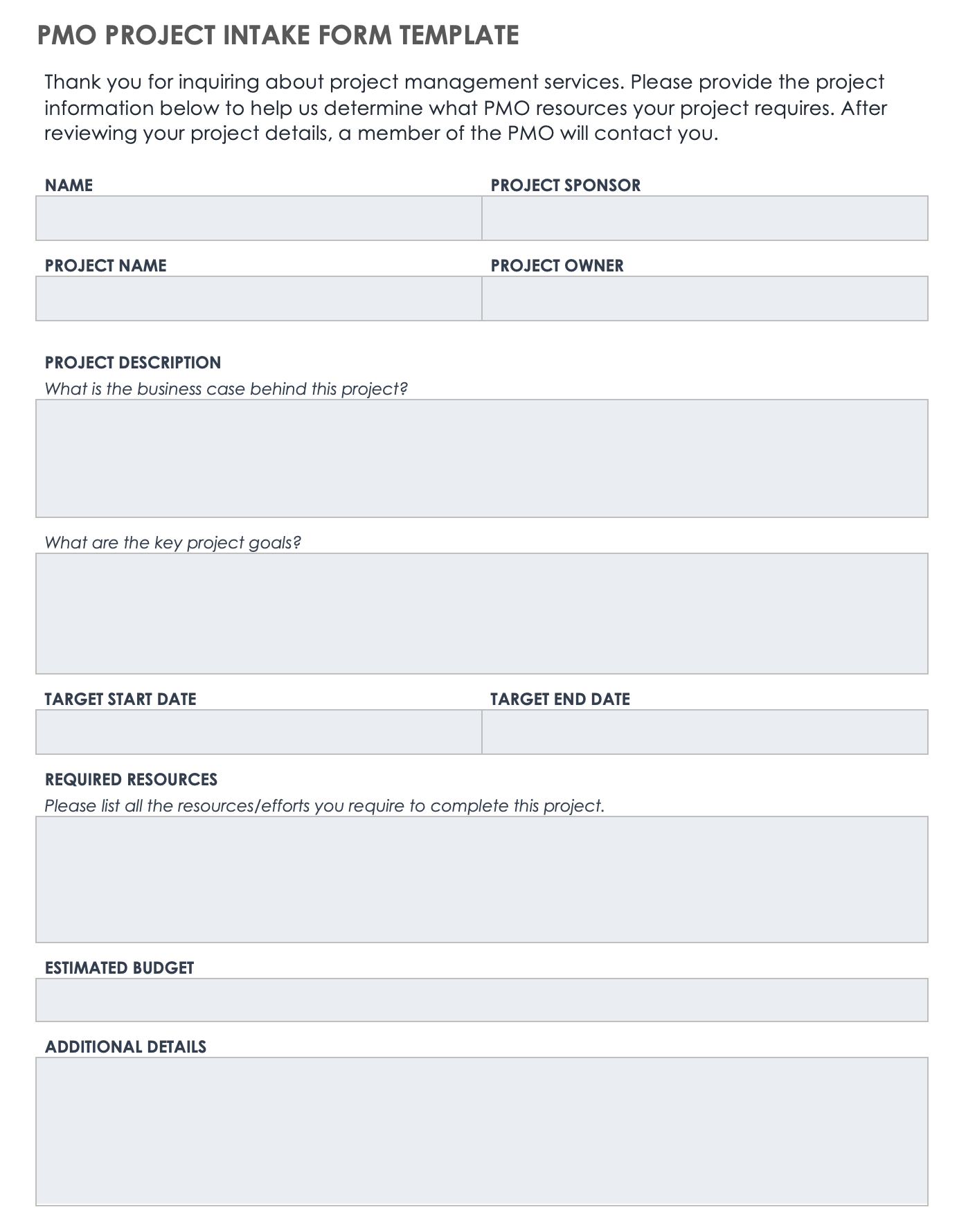What Is An Intake Form? A Comprehensive Guide For Healthcare Providers
An Intake Form: A Vital Tool for Healthcare Providers
As a healthcare provider, you’re constantly juggling multiple responsibilities. Streamlining your processes is crucial for efficiency and patient care. An intake form can be a game-changer in this regard. But what exactly is an intake form, and how can it benefit you?
An intake form is a standardized document that collects essential information from patients during their initial visit. It captures a wide range of data, including demographics, medical history, current symptoms, and lifestyle habits. This comprehensive snapshot allows you to make informed decisions and provide tailored care from the get-go.

Project Intake Form Template Excel – Source template.mapadapalavra.ba.gov.br
Types of Intake Forms for Healthcare Providers
Intake forms vary depending on the healthcare setting and specialty. Some common types include:
- Patient registration forms
- Medical history questionnaires
- Physical examination forms
- Psychiatric evaluation forms
- Dental intake forms
These forms can be paper-based or electronic, with the latter becoming increasingly popular due to its convenience and efficiency.

Free Printable Medical Intake Forms – Printable Forms Free Online – Source printableformsfree.com
Benefits of Using Intake Forms for Healthcare Providers
Incorporating intake forms into your practice offers numerous advantages:
- Improved patient engagement: Forms give patients an active role in their healthcare by providing them with a structured way to share their concerns and expectations.
- Enhanced efficiency: Pre-populated forms save time during appointments, allowing you to focus on providing care rather than gathering information.
- Increased accuracy: Standardized forms minimize transcription errors and ensure consistency in data collection.
- Improved communication: Forms facilitate efficient information exchange between healthcare team members, ensuring continuity of care.
- Enhanced patient experience: By streamlining the initial visit process, intake forms contribute to a seamless and positive patient experience.

Mental Health Evaluation Form Fillable Printable Pdf And Forms | The – Source www.babezdoor.com
Personal Experience with Intake Forms
As a patient, I’ve witnessed firsthand the benefits of intake forms. During my recent physical exam, the electronic intake form I filled out prior to the appointment allowed the physician to quickly review my medical history and address my concerns without wasting time on unnecessary questions.
In the past, paper-based forms often resulted in incomplete or inaccurate information due to illegible handwriting or misinterpretations. Electronic intake forms eliminate these issues, ensuring that my healthcare providers have the most up-to-date and accurate information about my health.

Life Coaching Intake Form Template – Printable Word Searches – Source davida.davivienda.com
History and Evolution of Intake Forms
Intake forms have a long history in healthcare. Early forms were used to document patient demographics and medical conditions. Over time, they evolved to include more comprehensive information, such as social history, lifestyle habits, and insurance details.
The advent of electronic health records (EHRs) has significantly impacted intake forms. EHR-integrated intake forms streamline data entry and sharing, enhancing efficiency and reducing the risk of errors. As healthcare technology continues to advance, we can expect intake forms to become even more sophisticated and user-friendly.

Free Client Intake Form Template – Printable Templates – Source templates.udlvirtual.edu.pe
Hidden Secrets of Intake Forms
Beyond their obvious benefits, intake forms hold hidden secrets that can further enhance their value:
- Early identification of risk factors: Intake forms can help identify patients at risk for certain conditions or complications by prompting them to provide information about family history, lifestyle habits, and current concerns.
- Patient self-monitoring: Forms can include sections where patients track their symptoms or progress over time, facilitating self-management and early intervention.
- Targeted patient education: Based on the information collected in the intake form, healthcare providers can tailor patient education materials and interventions to address specific needs.

Nutrients | Free Full-Text | Updating the Food-Based Dietary Guidelines – Source www.mdpi.com
Recommended Practices for Using Intake Forms
To maximize the benefits of intake forms, consider these recommendations:
- Collaborate with patients: Explain the purpose of the intake form and encourage patients to actively participate in completing it.
- Review forms carefully: Take time to review and verify the information provided in the intake form before making clinical decisions.
- Use technology to your advantage: Implement electronic intake forms to streamline data entry and improve accuracy.
- Provide clear instructions: Ensure that the intake form is easy to understand and complete, with clear instructions for each section.
- Update forms regularly: Regularly review and update your intake forms to reflect changes in practice policies or clinical guidelines.

Medical Intake Form Template – Source old.sermitsiaq.ag
Key Considerations for Intake Forms
When designing or using intake forms, consider the following key factors:
- Patient privacy and confidentiality: Ensure that intake forms comply with all applicable privacy and confidentiality regulations.
- Cultural sensitivity: Adapt intake forms to meet the cultural and linguistic needs of your patient population.
- Accessibility: Make intake forms accessible to patients with disabilities, including providing alternative formats upon request.
- Interoperability: Ensure that electronic intake forms are compatible with your existing EHR system.
- Legal compliance: Review intake forms with your legal counsel to ensure compliance with all relevant laws and regulations.

Free Printable Intake Forms – Printable Forms Free Online – Source printableformsfree.com
Fun Facts about Intake Forms
Here are a few fun facts about intake forms:
- The first known intake form was used in ancient Egypt around 2500 BC.
- The average healthcare provider spends approximately 15 minutes reviewing intake forms per patient.
- Electronic intake forms can save up to 50% of the time spent on data entry compared to paper-based forms.
- Some intake forms include interactive elements, such as drop-down menus and auto-fill suggestions, to enhance the user experience.
- Intake forms can be integrated with artificial intelligence (AI) tools to analyze patient data and identify potential health risks.

What Is A Patient Intake Form – Printable Form, Templates and Letter – Source projectopenletter.com
How to Use Intake Forms Effectively
To use intake forms effectively, follow these steps:
- Plan and design: Determine the specific information you need to collect and design the intake form accordingly.
- Implement: Introduce the intake form into your practice and provide clear instructions to patients and staff.
- Monitor and evaluate: Regularly review the intake forms to identify areas for improvement and ensure that they are meeting their intended purpose.
- Update and modify: As your practice evolves, update the intake form to reflect changes in policies, procedures, or patient demographics.
- Collaborate with patients: Encourage patients to actively participate in completing the intake form to ensure accuracy and completeness.

Printable Client Intake Form Template – Source dl-uk.apowersoft.com
What if You Don’t Use Intake Forms?
Not using intake forms can have significant consequences:
- Inefficient data collection: Manual data collection methods are prone to errors and omissions, leading to incomplete patient records.
- Delayed care: Without standardized intake forms, healthcare providers may spend excessive time gathering patient information, delaying the provision of care.
- Missed opportunities: Intake forms provide an opportunity to identify potential health risks and address patient concerns early on. Missing out on this information can compromise patient care.
- Poor communication: Lack of standardized intake forms can result in inconsistent information being collected from patients, leading to communication gaps between healthcare team members.
- Missed revenue opportunities: Accurate and comprehensive intake forms are essential for proper billing and reimbursement.
Listicle: Benefits of Using Intake Forms
Here’s a listicle summarizing the benefits of using intake forms:
- Improved patient engagement
- Enhanced efficiency
- Increased accuracy
- Improved communication
- Enhanced patient experience
- Early identification of risk factors
- Patient self-monitoring
- Targeted patient education
- Streamlined data entry
- Compliance with privacy and confidentiality regulations
Question and Answer
Here are some frequently asked questions about intake forms:
- What is the purpose of an intake form?
An intake form is used to collect essential patient information during their initial visit.
- What types of information are typically included on an intake form?
Intake forms typically include patient demographics, medical history, current symptoms, lifestyle habits, and insurance information.
- What are the




